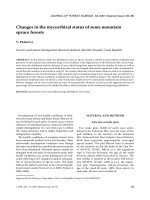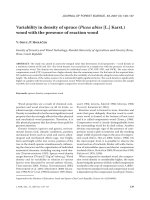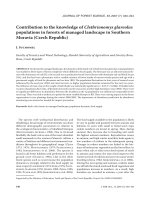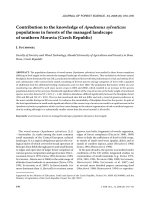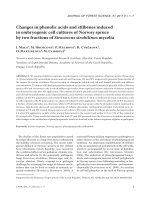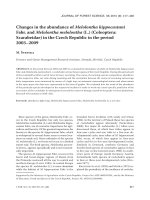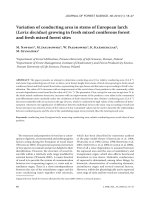Báo cáo lâm nghiệp: "Variation in the composition and content of ellagitannins in the heartwood of European oaks (Quercus robur and Q petraea). A comparison of two French forests and variation with heartwood age" ppt
Bạn đang xem bản rút gọn của tài liệu. Xem và tải ngay bản đầy đủ của tài liệu tại đây (716.28 KB, 14 trang )
Original
article
Variation
in
the
composition
and
content
of
ellagitannins
in
the
heartwood
of
European
oaks
(Quercus
robur and
Q
petraea).
A
comparison
of
two
French
forests
and
variation
with
heartwood
age
JR
Mosedale
B
Charrier
2
N
Crouch
3
G
Janin4
PS
Savill
1
1
Department
of
Plant
Sciences,
Oxford
Forestry
Institute,
University
of
Oxford, South
Parks
Road,
Oxford
OX1
3RB,
UK;
2
École
supérieure
du
bois,
CP
3029,
rue
Christian-Pauc,
44087
Nantes
cedex
03,
France;
3
Dyson
Perrins
Laboratory,
University
of
Oxford,
South
Parks
Road,
Oxford
OX1
3QY,
UK;
4
Station
de
recherches
sur
la
qualité
des
bois,
Inra,
54280
Champenoux,
France
(Received
3
March
1995;
accepted
28
July
1995)
Summary -
The
ellagitannin
concentration
was
measured
in
water
extracts
of
different
heartwood
sections
of
Pressler
cores
from
three
Russian
and
one
English
Quercus
roburtree.
As
the
heartwood
age
increased,
the
concentration
of
total
soluble
ellagitannins
showed
a
logarithmic
decline,
while
individual
ellagitannins
varied
in
their
response.
A
simple
model
relating
the
total
soluble
ellagitannins
and
heartwood
age
was
calculated.
In
a
second
study
two
heartwood
samples
were
taken
from
each
of
20 oak
trees
(Q
roburand
Q
petraea)
from
each
of
two
contrasting
(Limousin
and
Tronçais)
French
forests.
Over
70%
of
the
total
variation
in
the
concentration
of
water
soluble
ellagitannins
and
total
phenolics
extracted
from
the
samples
was
attributed
to
differences
between
forests,
while
relatively
little
variation
occurred
between
the
two
within-tree
samples.
Lower
concentrations
were
found
in
more
slowly
grown
timber
from
the
Tronçais
forest
than
in
wood
from
the
Limousin
region.
The
different
tannin
concentrations
could
not
be
explained
solely
by
the
greater
heartwood
age
of
Tronçais
samples
if
one
assumed
that
the
rate
of
ellagitannin
decline
with
heartwood
age
was
similar
in
all
trees.
A
correlation
between
wood
colour,
as
defined
by
CIELab
colour
parameter
hue,
colour
saturation
and
b*
(representing
colour
along
the
blue-yellow
axis),
and
total
phenolics
and
soluble
tannins
was
also
observed.
The
two
forests
differed
in
many
regards,
including
environmental
conditions,
silvicultural
practices
and
the
dominant
species.
Quercus
robur /
Quercus
petraea
/
CIELab
colour
/ ellagitannins
/
heartwood
age
Résumé -
Variation
de
la
composition
et
de
la
teneur
en
ellagitannins
dans
le
bois
de
cœur
des
chênes
européens
(Quercus
robur,
Q petraea).
Comparaison
de
deux
forêts
françaises
et
variations
en
fonction
de
l’âge
du
bois
de
cœur.
La
concentration
des
ellagitannins
a
été
mesurée
dans
les
extraits
acqueux
des
différentes
parties
du
bois
de
cœur
de
carottes
de
sondage
provenant
de
trois
chênes
(Quercus
robur)
prélevés
en
Russie
et
un
prélevé
en
Angleterre.
La
concentration
des
ellagitanins
solubles
totaux
présentait
une
diminution
logarithmique
au
fur
et
à
mesure
que
l’âge
du
bois
augmentait,
tandis
que
les
divers
ellagitanins
présentaient
des
teneurs
variables.
Un
modèle
simple
reliant
la
concentration
en
ellagitanins
solubles
totaux
avec
l’âge
a
été
établi.
Dans
une
étude
ultérieure,
deux
échantillons
de
bois
de
cœur
provenant
chacun de
20
chênes
européens
(Q
robur
et
Q
petraea)
issus
chacun de
deux
forêts
françaises
très
différentes
(Limousin
et
Tronçais).
Plus
de
70
%
de
la
variation
totale
de
la
concentration
en
ellagitanins
solubles
extraits
de
ces
échantillons
a
été
attribuée
à
la
différence
entre
les
forêts,
tandis
qu’une
relativement
faible
variation
pouvait
être
attribuée
aux
deux
échantillons
prélevés
à
l’intérieur
de
chaque
arbre.
Les
teneurs
en
tanins
solubles
étaient
plus
faibles
chez
les
arbres
provenant
de
la
forêt
Tronçais
que
chez
ceux
de
la
région
du
Limousin,
et
ceci
ne
pouvait
pas
être
expliqué
seulement
par
les
légères
différences
d’âge
du
bois
de
cœur
des
échantillons.
Une
corrélation
entre
la
couleur
du
bois,
mesurée
dans
le
système
CIELab
avec
les
paramètres
de
teinte
(h),
de
saturation
(C)
et
la
coor-
donnée
chromatique
(b*),
la
teneur
en
phénols
totaux
et
les
tanins
solubles
a
été
aussi
observée.
Les
deux
forêts
présentaient
bien
des
différences
du
point
de
vue
de
l’environnement,
des
traite-
ments
sylvicoles
et
des
dominances
d’espèces.
Quercus
robur
/ Quercus
petraea
/
couleur
CIELab
/
ellagitanins
/
âge
du
bois
de
cœur
INTRODUCTION
The
hydrolyzable
tannins
have
been
estimated
to
comprise
up
to
10%
of
the
dry
weight
of
hear-
twood
of
European
oak
(Scalbert
et
al,
1988).
Numerous
studies
have
reported
how
the
concentration
of
soluble
tannins
declines
as
the
age
of
the
heartwood
increases,
away
from
the
sapwood
boundary
towards
the
pith
of
trees
(Peng
et
al, 1991;
Klumper-
s
et
al,
1994;
Viriot
et
al,
1994;
Charrier
et
al,
1995).
However,
Viriot
et
al
(1994)
re-
ported
how
the
concentration
of
individual
ellagitannins
responded
in
different
ways
to
heartwood
age.
They
proposed
a
series
of
reactions
as
occurring
during
heartwood
ageing.
During
the
first
30
years
of
ageing,
there
is
conversion
from
monomeric
to
dimeric
tannins.
Hydrolysis
reactions
occur
throughout
heartwood
ageing
at
a
slow
rate
estimated
as
1
%
of
the
total
every
10
years.
However,
the
polymerization
of
ellagitan-
nins
into
larger
polyphenols
is
thought
to
be
the
main
cause
of
the
decline
in
soluble
tannins
as
heartwood
ages.
Few
studies
have
examined
the
degree
of
variation
in
ellagitannin
concentrations
that
occurs
between
trees,
populations
and
the
two
European
oak
species
Q
petraea
(Matt)
and
Q
robur
L.
Levels
of
tannins
in
the
heartwood
of
these
two
species
have
been
reported
to
be
greater
than
those
found
in
the
heartwood
of
American
white
oak
such
as
Q
alba
L
(Rous
and
Alderson,
1983;
Quinn
and
Singleton,
1985;
Miller
et
al,
1992).
There
is
also
a
long
tradition
within
the
wine-
and
brandy-making
indus-
tries
that
the
flavour
imparted
by
oak
casks
varies
according
to
the
geographic
origins
of
the
oak
wood
used
in
their
construction.
Although
the
role
of
the
hydrolyzable
tan-
nins
in
influencing
flavour
is
uncertain
(Vi-
riot
et
al,
1993),
it
is
probable
that
the
con-
centration
and
composition
of
oak
wood
extract
will
influence
flavour
imparted
by
oak
casks.
However,
as
reviewed
by
Mose-
dale
(1995),
numerous
factors
may
in-
fluence
the
extractive
properties
of
oak
wood.
The
few
studies
that
have
compared
different
species
or
origins
of
European
oak
wood
have
generally
failed
to
control
other
influencing
factors
sufficiently
(such
as
wood
age
and
storage
conditions)
or
repli-
cation
has
been
insufficient
(eg,
Puech,
1984;
Miller et al,
1992;
Marco
et
al,
1994).
Studies
of
the
variability
of
other
wood
properties,
such
as
density,
have
generally
concluded
that
the
greatest
degree
of
vari-
ation
occurs
between
different
trees
within
a
forest
and
between
provenances
(Zobel
and Talbert,
1984).
The
primary
aim
of
this
study
was
to
examine
the
variation
in
soluble
ellagitan-
nins
of
European
oak
wood
between
and
within
trees
felled
in
two
forest
coupes.
The
forests
were
selected
to
correspond
to
two
opposing
types
of
French
oak
that
are
used
by
the
cooperage
industry
and
frequently
claimed
to
have
different
effects
on
the
fla-
vour
of
wine
and
brandy.
To
determine
the
relative
importance
of
variation
between
and
within
mature
trees,
additional
samples
were
used
to
confirm
the
variation
of
soluble
ellagi-
tannins
with
heartwood
age.
MATERIALS
AND
METHODS
Materials
Variation
within
trees
A
core
was
taken
with
a
Pressler
borer
at
breast
height
from
each
of
four
trees
of
between
100-
120
years
of
age.
Three
of
the
trees
came
from
an
oak
forest
near
Voronezh,
Russia,
having
been
collected
in
May
1993,
while
the
other
was
from
an
isolated
field
boundary
oak
near
Oxford,
taken
in
1990.
All
the
trees
were
Quercus
robur
and
displayed
regular
and
rapid
growth
throug-
hout
the
core
lengths.
The
cores
were
cut
into
different
sections
according
to
the
age
of
the
heartwood
from
the
heartwood-sapwood
boundary:
0-5,
6-10,
11-20
yearsand
so
on
in
steps
of
10
years
up
to
40-70
years
according
to
the
tree.
Wood
samples
from
each
zone
were
ground
to
less
than
100
mesh
and
soluble
ellagi-
tannins
measured.
Variation
between
two
forests
Trees
were
compared
from
two
forests
that
typi-
fied
contrasting
types
of
French
oaks used
for
the
construction
of
casks
(table
I).
The
trees
felled
were
of
suitably
high
standards
for
cooper-
age.
By
the
choice
of
two
such
contrasting
sites
it
was
intended
to test
the
hypothesis
that
it
is
not
feasible
to
select
for
cooperage
wood
with
signi-
ficant
differences
in
wood
extractives.
One
site
was
located
in
a
forest
near
Tronçais,
the
other
in
the
Limousin
region
of
France.
From
each
of
these
clear
felled
sites
20
randomly
se-
lected
trees,
of
suitable
quality
for
cooperage,
were
chosen.
During
the
splitting
of
logs
and
cut-
ting
of
bolts,
two
staves
were
removed
and
used
for
this
study.
These
staves
were
cut
from
the
outer
heartwood,
near
the
base
of
north
and
south
facing
sides
of
the
bole.
Therefore,
for
each
site
a
total
of
40
samples
from
20
trees
were
examined.
The
80
staves
were
stored
for
approximately
4
months
before
a
hand-held
plane
was
used
to
remove
shavings
from
their
surfaces
that
would
make
up
the
inner
face
of
a
barrel.
After
removal
of
the
frequently
discoloured
outer
surface
of
the
stave,
shavings
from
the
top
1-2
mm
were
taken
and
were
then
ground
(Glen
Creston
type
14-
580
mill)
and
air-dried
to
reduce
moisture
con-
tent
to
approximately
4%
of
dry
weight.
Methods
Determination
of
soluble
ellagitannins
The
concentrationof
soluble
ellagitannins
ex-
tracted
from
samples
of
each
French
oak
stave
and
of
each
heartwood
age
zone
from
the
four
Pressler
cores
was
measured.
The
ellagitannins
were
extracted
from
50
mg
of
wood
over a
period
of
24
h
at
room
temperature
with
5
mL
of
the
extracting
solution:
methanol/H
2
O/H
3
PO
4
2/97/1
v/v/v,
with
100
mg/L
of
pyrogallol
used
as
the
internal
standard.
After
filtration
the
concentra-
tion
of
ellagitannins
was
determined
by
high
per-
formance
liquid
chromatography
(HPLC).
The
solvent
system
allowed
direct
injection
without
further
analytical
steps
and
was
found
to
give
better
separation
of
early
peaks
than
solvents
containing
higher
proportions
of
methanol.
Column:
Waters
reverse-phase
C18; 260
x
4
mm;
Spherisorb
packing.
Injection
volume:
20
I.
Detec-
tion:
at
230
nm
(190-400
nm
for
dentification).
Internal
standard:
pyrogallol
(Aldrich)
at
100
mg/L
extraction
solution.
Gradient.
The
fol-
lowing
solutions
were
used:
H2
O/H
3
PO
4
99/1
v/v
(solvent
A);
MeOH/H
3
PO
4
99/1
v/v
(solvent
B).
The
best
separation
of
ellagitannins
was
ob-
tained
using
a
linear
gradient
from
0
to
9%
of
solvent
B
over
40
min.
Identification
and
calibration
Using
the
criteria
suggested
by
Scalbert
et
al
(1990),
that
ellagitannins
have
near
identical
ab-
sorption
spectra
with
no
maxima
between
240-
400
nm
but
a
shoulder
around
280
nm,
12
possible
ellagitannins were
identified.
Acompari-
son
of
the
relative
retention
times
with
results
described
in
earlier
studies
(Scalbert
et
al,
1988;
Viriot
et
al,
1994)
allowed
the
identification
of
nine
of
these
12
ellagitannins
(fig
1).
Purified
samples
of vescalagin,
castalagin,
grandinin
and
roburin
A
(kindly
provided
by
Dr
Scalbert,
INRA,
Paris)
allowed
confirmation
of
their
identification
and
were
used
for
calibration.
Measurement
of
total
phenolics
Folin
Denis
reagent
(AOAC,
1984,
1990;
Scal-
bert,
1992)
was
used
to
measure
the
total
phenolics
in
the
extracts
of
the
80
French
oak
samples.
One
mL of
Folin
Denis
reagent
(Fisons
diluted
1:4
with
water),
was
added
to
1
mL
of
the
extraction
solution
followed
by
1
mL
of
a
3%
so-
dium
carbonate
solution.
After
agitation,
the
samples
were
placed
in
a
water
bath
at
50
°C
for
20
min.
After
cooling
for
5
min,
absorbance
at
760
nm
was
measured.
Calibration
of
the
spec-
trophotometer
was
performed
for
each
batch
of
samples
using
gallic
acid
(Aldrich)
solutions
and
the
results
were
expressed
as
gallic
acid
equi-
valents
(GAE).
Extract
solutions
were
suitably
diluted,
typically
by
1:5
with
water.
Insoluble
ellagitannins
Insoluble
ellagitannins
in
wood
can
be
estimated
by
degradation
in
alcohol-hydrochloric
acid
sol-
utions
measuring
the
resulting
ellagic
acid
by
HPLC
or
GC
(Puech
et
al,
1990;
Peng
et
al,
1991;
Scalbert,
1992).The
concentration
of
inso-
luble
ellagitannins
was
determined
in
wood
samples
from
one
Limousin
and
one
Troncais
stave.
Three
replicate
extractions
of
wood
samples
from
each
stave
were
carried
out
in
Te-
flon
tubes,
using
the
solvent
and
conditions
de-
scribed
previously.
After
extraction
the
solvent
was
removed
with
a
syringe
fixed
with
a
fine
hy-
podermic
needle.
The
samples
were
air-dried
and
re-weighed
before
5
mL
of
MeOH/HCl
6M
9/1
v/v,
containing
0.5
mg
1-naphthol
(Aldrich)
was
added
to
each
of
the
residues.
After
heating
at
120
°C
for
160
minutes,
the
solutions
were
then
filtered
and
analysed
by
HPLC
to
determine
quantities
of
ellagic
acid,
which
were
expressed
as
castalagin
equivalents
(Peng
et
al,
1991;
Vi-
riot et al,
1994).
Column:
Waters
reverse-phase
C18;
260
x
4
mm;
Spherisorb
packing.
Injection
vol-
ume:
20
μL.
Detection:
at
280
nm
(190-400
nm
for
identification).
Internal
standard:
1-naphthol
(Aldrich).
Gradient:
The
following
solvents
were
used:
H2
O/H
3
PO
4
99/1
v/v
(solvent A)
and
MeOH/H
3
PO
4
99/1
v/v
(solvent
B)
to
run
a
linear
gradient
from
0
to
100%
solvent
B
over
30
minutes
with
a
flow
rate
of
1
mL/min.
Measurement
of
wood
colour
and
ring
width
Ten
measurements
of
wood
colour
were
made
across
a
cleanly
cut
transverse
section
(radial
face)
of
each
French
oak
stave.
Mean
ring
widths
were
also
determined.
Colour
was
measured
with
a
Colorquest
Hunterlab
spectrocolourimeter
using
the
CIE
standard
illuminant
D65
(corre-
sponding
to
daylight
under
an
overcast
sky)
and
an
observation
angle
of
10°.
This
measured
the
percentage
of
reflected
light
at
32
wavelengths,
distributed
at
10
nm
intervals
between
400
and
710
nm.
The
reflectance
spectrum
was
repre-
sented
by
the
CIELab
system,
which
has
been
widely
used
in
previous
studies
of
wood
colour
(eg,
Janin,
1987;
Klumpers
et
al,
1994, 1993;
Charrier
et
al,
1995).
The
system
represents
col-
our
using
L
(lightness)
and
the
chromatic
coordi-
nates
a*
(red-green
axis)
and
b*
(blue-yellow
axis).
Additional
parameters
used
to
describe
colour
may
be
derived
from
these
variables.
These
include
the
angle
of
taint
or
hue,
h
=
arc-
tan
(b*/a*)
and
colour
saturation :
RESULTS
Variation
of
ellagitannins
with
heartwood
age
Due
to
the
overlap
of
the
peaks
for
gallic
acid
and
roburin
B
in
some
samples,
both
these
were
excluded
from
analyses.
The
variations
in
ellagitannin
concentrations
are
illustrated
in
figure
2.
The
results
indi-
cate
that
as
well
as
a
general
decline
in
ellagitannins,
the
individual
tannins
re-
spond
differently
during
ageing.
Vescalagin,
the
most
abundant
ellagitan-
nin
in
outer
heartwood,
is
seen
to
decrease
rapidly
during
the
first
20
or
30
years
of
ageing,
after
which
the
decline
lessens
or
even
ceases.
Castalagin,
less
abundant
than
vescalagin
in
outer
heartwood,
de-
clines
at
a
slower
and
more
constant
rate,
becoming
the
most
abundant
tannin
in
older
heartwood.
The
other
ellagitannins
show
more
diverse
patterns
of
variation.
The
dimer
roburin
D
shows
a
similar
pattern
to
vescalagin,
which
contrasts
with
the
vari-
ation
of
roburins
A
and
C.
Roburin
A
in-
creases
in
concentration
during the first
10
years
of
ageing
and
roburin
C
over
the
first
30
years,
before
each
declines
again
in
older
wood.
Grandinin
and
roburin
E show
less
clear
patterns,
but
in
general
concen-
trations
remain
approximately
constant
during
the
first
30
years
before
declining.
The
concentration
of
ellagitannins
in
each
heartwood
zone
was
then
expressed
as a
percentage
of
that
in
the
youngest
hear-
twood
(years
0-5).
The
means
and
stand-
ard
error
bars
for
all
four
trees
are
shown
in
figure
3.
This
displays
a
logarithmic
de-
cline
with
heartwood
age.
The
following
simple
linear
model
was
fitted:
where
a
is
the
heartwood
age;
Ta
is
the
concentration
of
ellagitannins
at
age
a
and
T
oh
where a = 0.
This
gives
an
estimate
for
b
of
-0.0219
with
a
standard
error
of
0.0007
and
an R
2
0.988.
Therefore,
if
one
knows
the
level
of
tannins
in
the
outermost
heartwood,
that
in
the
heartwood
of
age
a
may
be
estimated
by
Ta
=
T
oh
/
e
0.0219a
.
Between-
and
within-forest
variation
Figure
4
shows
the
concentration
of
ellagi-
tannins
in
north
-and
south-facing
staves
of
each
tree
plotted
on
opposing
axes.
As
well
as
illustrating
the
difference
between
the
two
forests,
the
fact
that
most
of
the
points
lie
approximately
along
a
gradient
of
one
indicates
that
there
were
similar
concentra-
tions
in
each
of
the
staves
from
the
same
tree.
The
lower
variation
among
samples
from
the
Tronçais
forest
than
those
from
the
Limousin
is
also
apparent
and
the
data
were
log-transformed,
resulting
in
more
ho-
mogeneous
variances.
A
balanced,
nested
analysis
of
variance
was
used
to
compare
the
variation
between
and
within
trees
and
forests.
The
results
and
the
large
proportion
of
variance
explained
by
between-tree
and
between-forest
variation
are
shown
in
table
II.
The
two
samples
from
each
tree
were
treated
as
random
repli-
cates
for
this
analysis.
Due
to
one
tree
hav-
ing
only
a
single
replicate,
both
this
tree
and
the
data
of
a
random
tree
from
the
other
site
were
removed
from
analysis,
reducing
the
total
degrees
of
freedom
to
37
within
each site.
By
calculating
Spearman
correlation
coefficients,
highly
significant
correlations
were
found
between
all
the
individual
el-
lagitannins.
The
strongest
correlation
was
that
between
total
phenolics
and
total
el-
lagitannins,
with
an
R
value
of
0.99.
This
suggests
that
the
Folin
Denis
method
is
an
effective
means
of
comparing
the
tannin
contents
of
oak
wood,
supporting
results
described
by
Puech
et
al
(1990).
Viriot
et
al
(1995)
reported
that
heartwood
ellagitan-
nin
content
determined
by
the
Folin
method
was
less
affected
by
heartwood
age.
Table
II
shows
that
the
difference
between
the
forests
was
only
slightly
lower
for
total
phenols
than
for
total
ellagitannins.
Wood
colour
and
ring
widths
Of
the
three
variables
lightness
(L*),
a*
and
b*
used
to
define
wood
colour,
lightness
varied
most.
However,
analyses
of
vari-
ance
found
that
only
b*
and
the
derived
variables
hue
and
colour
saturation
varied
significantly
between
the
two
forests,
while
significant
variation
between
trees
and
samples
was
found
for
all
three
variables.
Variance
components
(see
table
III)
show
that
the
between-forest
variation
ac-
counted
for
a
relatively
small
amount
of
the
total
variation
of
wood
colour.
Greater
be-
tween
forest variation
was
found
for
ring
width,
with
the
Limousin
samples
having
much
wider
rings
than
those
from
Tronçais
(table
II).
Among
the
wood
colour
par-
ameters,
the
variable
b*
(blue-yellow
axis)
correlated
most
strongly
with
tannin
con-
tent
both
separately
for
each
forest
and
when
the
data
for
the
two
are
grouped
(R
grouped
=
0.640).
Despite
scatter
this
trend
is
perceptible
in
figure
5.
Similar
correlations
were
found
between
total
tan-
nins
and
both
hue and
colour
saturation
which
correlate
strongly
with
b*.
Composition
of
ellagitannins
In
order
to
test
whether
the
composition
of
ellagitannins
varied
between
sites,
the
per-
centage
of
each
ellagitannin
was
calcu-
lated
in
relation
to
total
soluble
ellagitan-
nins.
A
nested
analysis
of variance
was
car-
ried
out
on
arcsine-transformed
percent-
age
data.
A
nonparametric
comparison
of
the
two
sites
was
also
carried
out
by
a
Wil-
coxon
two-sample
test
of
rank
sums
(SAS
Institute
Inc, 1985;
Neave
and
Worthington,
1988).
Both
the
parametric
and
nonpar-
ametric
tests
found
significant
differences
between
the
two
sites
for
most
of
the
ellagi-
tannins
(table
IV).
The
most
prominent
dif-
ference
was
the
lower
proportion
of
vesca-
lagin
in
the
Tronçais
samples.
It
has
been
previously
observed
that
the
proportion
of
vescalagin
varies
with
hear-
twood
age.
The
results
suggest
that
the
Tronçais
samples
are,
on
average,
cut
from
older
heartwood
than
the
Limousin
samples.
This
is
confirmed
by
the
slower
growth,
as
indicated
by
narrower
ring
widths,
of
Tronçais
trees
which
results
in
the
average
heartwood
age
of
these
samples
being
greater
than
Limousin
samples.
Influence
of
wood
age
on
soluble
ellagitannins
One
could
propose
that
the
difference
in
tan-
nin
concentrations
between
the
two
forests
is
simply
due
to
the
difference
in
heartwood
age
of
the
samples.
Greater
insolubulization
or
hydrolysis
of
soluble
ellagitannins
may
have
occurred
in
the
older
samples
from
Tronçais.
different
approaches
were
used
to
ad-
dress
this
possibility.
Estimating
soluble
tannin
decline
due
to
heartwood
age
The
heartwood
age
of
samples
from
each
forest
can
be
estimated
from
ring
widths.
If
one
assumes
that
all
staves
are
7
cm
across
in
transverse
section
with
the
near-
est
edge
cut
2.5
cm
from
the
sapwood
boundary,
one
can
calculate
average
hear-
twood
age
assuming
constant
annual
growth
equal
to
the
mean
ring
widths
for
each
forest
(see
table
V).
Using
this
estimate
of
mean
heartwood
age
as
a
and
the
mean
total
ellagitannins
found
in
samples
from
each
forest
(table
II)
as
Ta,
the
concentrations
of
tannins
in
the
new,
outermost
heartwood
T
oh
can
be
esti-
mated
using
the
model
developed
earlier,
where
T
oh =
Tae
(0.0219a)
.
Table
V
shows
that
there
remains
a
large
difference
between
the
two
forests
in
the
estimated
soluble
ellagitannins
of
new
heartwood.
Measurement
of
insoluble
tannins
in
two
samples
Table
VI
gives
the
mean
concentrations
of
insoluble
ellagitannins
remaining
in
samples
of
Limousin
and
Tronçais
wood
after
water
extractions.
The
concentration
of
insoluble
ellagitannins
is
probably
slightly
overestimated
as
the
free
ellagic
acid
present
in
the
wood,
formed
from
the
natural
hydrolysis
of
ellagitannins,
was
not
measured.
Although
slightly
soluble
in
water
the
majority
of
free
acid
will
have
re-
mained
in
wood
residues.
Viriot
et
al
(1994)
calculated
the
concentration
of
ellagic
acid
at
the
sapwood/heartwood
boundary
as
representing
10%
of
the
total
ellagitannins,
with
1 %
of
ellagitannins
hydrolyzed
into
el-
lagic
acid
every
following
10
years.
The
dif-
ference
in
total
ellagitannins
between
the
two
samples
is
greater
than
that
indicated
from
the
earlier
calculations,
suggesting
that
the
earlier
assumptions
over-rather than
under-
estimated
the
difference
in
heartwood
age.
Overall,
these
results
suggest
that
the
dif-
ferences
in
tannin
concentrations
between
the
forests
cannot
be
explained
solely
by
a
difference
in
the
heartwood
age
of
the
samples,
if
one
assumes
that
the
rate
of
reactions
which
occur
during
ageing
is
similar
in
all
trees.
DISCUSSION
The
increase
in
the
concentrations
of
ro-
burins
A,
C
and
possibly
other
dimers
dur-
ing
the
first
10-30
years
of
ageing
are
due
to
their
synthesis
from
other
tannins
(Viriot
et
al,
1994).
This
implies
that
the
monomers
vescalagin
and
castalagin
may
transform
directly
or
indirectly
to
dimers.
The
rapid
decline
in
vescalagin
corre-
sponds
with
an
increase
in
concentrations
of
these
dimers.
Roburin
D
(vescalagin-
castalagin)
increases
later
than
roburins
A
and
C
possibly
due
to
the
slower
decline
in
castalagin.
These
results
from
four
trees
of
Q
robur support
those
of
Viriot
et
al
(1994),
which
were
taken
from
measurements
of
single
trees
of
Q
petraea
and
Castanea
sativa.
A
high
degree
of
variation
in
the
soluble
tannins
is
demonstrated
between
the
two
forests.
The
low
within-tree
variation
was
probably
due
to
the
restrictions
placed
on
the
sampling,
with
samples
taken
of
only
cask-quality
wood
from
the
outer
hear-
twood
near
the
base
of
each
tree.
The
forests
sampled
were
selected
to
corre-
spond
to
contrasting
criteria
used
within
the
cooperage
industry
to
select
wood.
There-
fore
the
relative
proportion
of
variation
ex-
plained
by
between-forest
differences
should
be
treated
as
an
upper
limit
of
the
variation
that
could
feasibly
be
selected
for
by
coopers.
Singleton
(1974)
found
that
tannin
concentrations
were
greater
in
the
earlywood
compared
to
the
latewood
of
an-
nual
rings
and
therefore
proposed
that
oak
wood
with
narrow
rings
would
contain
higher
levels
of
tannins
due
to
the
higher
proportion
of
earlywood.
Hillis
(1975)
also
suggested
that
slow
growing
trees
would
contain
higher
levels
of
heartwood
poly-
phenols
due
to
the
greater
’stress’
they
were
under.
However,
the
results
reported
here
give
no
support
to
these
hypotheses,
with
higher
levels
found
in
the
more
rapidly
grown
Limousin
wood.
Rapid
growth
due
to
a
more
intense
thin-
ning
regime
are
characteristic
of
the
mostly
privately
owned
forests
in
the
Limousin
re-
gion.
More
slowly
grown
oaks
will
be
felled
at
a
later
age
and
the
stave
wood
from
such
trees
will,
on
average,
be
older,
even
if
cut
from
the
same
location
within
the
tree.
Due
to
the
rapid
decline
in
soluble
tannins
ob-
served
in
the
first
20
years
of
heartwood
ageing,
this
might
significantly
influence
the
average
tannin
content.
Samples
used
in
this
study
comprised
between 12-50
years
of
heartwood
growth,
depending
on
ring
widths.
However,
the
results
and
cal-
culations
presented
here
strongly
suggest
that
differences
in
extracted
ellagitannins
cannot
be
explained
solely
by
differences
in
wood
age.
This
supports
the
findings
of
other
studies
(Mosedale
and
Savill
1996;
Mosedale
et
al,
1996)
which
have
found
significant
differences
between
species,
provenances
and
clones
of
young
oaks
in
the
total
ellagitannin
and
phenolic
content
of
outer
heartwood
of
the
same
age.
This
is
not
to
say
that
the
differences
may
not
be
due
to
variation
in
the
rates
of
reactions
which
occur
during
heartwood
ageing.
The
rate
of
oxidation
reactions
occurring
during
ageing
could,
for
example,
be
determined
by
variation
between
trees
and
sites
in
the
availability
of
metal
cations.
Figures
2
and
3
show that even
among
the
four
trees
used
to
calculate
the
model
there
was
variation
in
the
rate
of
ellagitannin
decline
with
hear-
twood
age.
It
has
been
previously
observed
that
inner
heartwood
is
darker
and
colour
saturation
more
pronounced
than
outer
heartwood,
and
that
tannins
may
play
a role
in
the
for-
mation
of
heartwood
colour
(Klumpers
and
Janin,
1992;
Klumpers
et
al,
1993,
1994).
The
results
reported
here
support
the
no-
tion
of
a
relationship
between
wood
colour
and
extractive
content;
however,
there
is
no
means
of
determining
whether
or
not
the
correlation
between
total
ellagitannins
and
the
wood
colour
parameter
b*
is
entirely
ex-
plained
by
the
different
heartwood
age
of
samples.
The
difference
in
ellagitannin
content
may
be
explained
by
different
rates
of
the
reac-
tions
taking
place
during
ageing,
or
by
a
difference
in
the
initial
concentrations
laid
down
in
the
heartwood.
One
could
alterna-
tively
propose
that
it
is
due
to
variation
of
other
heartwood
constituents
which
in-
fluence
ellagitannin
measurement,
al-
though
the
similar
differences
in
total
phenolics
makes
this
less
likely.
The
two
forests
differed
in
many
ways
and
this
makes
it
impossible
to
suggest
what
might
be
the
cause
for
the
large
differences
found
in
tannin
concentrations
through
whatever
mechanism.
However,
the
careful
sampling
and
treatment
of
wood
samples
after
fell-
ing,
and
the
large
proportion
of
variation
found
between
the
forests,
suggests
that
factors
beyond
the
local
forest
environment
influence
wood
tannin
concentrations.
Re-
cent
studies
(Mosedale
and
Savill,
1996;
Mosedale
et
al,
1996)
have
indicated
that
ellagitannin
content
is
under
strong
genetic
control
and
that
Q
robur trees
have
gener-
ally
greater
concentrations
than
Q
petraea.
The
results
of
this
study
are
in
agreement
with
this
observation,
with
higher
concen-
trations
found
in
the
heartwood
of
the
pre-
dominantly
Q
robur
Limousin
trees.
ACKNOWLEDGMENTS
The
authors
would
like
to
thank
A
Ford
of
United
Distillers
for
his
assistance
with
methodologies
and
C
Houssement
at
INRA,
Champenoux
for
colour
measurements.
G
Roy
and
JL
Giraud
at
Tonnellerie
Taransaud
were
invaluable
in
acquir-
ing
French
oak
samples
and
Pr
V
Vereshchagina
and
her
colleagues
at
the
University
of
Perm
and
at
Voronezh
provided
samples
from
Russia.
We
would
also
like
to
thank
the
referees
of
this
paper
for
their
constructive
comments.
The
work
was
funded
by
United
Distillers.
REFERENCES
AOAC
(1984)
Official Methods
of Analysis,
14th ed.
Sec-
tions
9.110-9.112.
Arlington,
VA,
USA
AOAC (1990)
Official
Methods
ofAnalysis,
15th
edition.
Section
952.03.
Arlington,
VA,
USA
Charrier
B,
Janin
G,
Haluk
JP,
Mosedale
JR
(1995)
Col-
our
and
visual
characteristics
of
moon
rings
in
oak
wood.
Holzforschung 49,
287-292
Hillis
WE
(1975)
Ethylene
and
extraneous
material
for-
mation
in
wood
tissues.
Phytochemistry
114, 2559-
2562
Janin
G
(1987)
Mesure
de
la
couleur
du
bois.
Intérêt
forestier
et
industriel.
Ann
Sci
For 44,
455-472
Klumpers
J, Janin
G
(1992)
Influence
of
age
and
annual
ring
width
on
the
wood
colour
of
oaks.
Holz
als
roh-
und
werkstoff
50,
1-5
Klumpers
J,
Janin
G,
Becker
M,
Levy
G
(1993)
The
influences
of
age,
extractive
content
and
soil
water
on
wood
colour
in
oak:
the
possible
genetic
determi-
nation
of
wood
colour.
Ann
Sci
For
50
(suppl
1),
166-285
Klumpers
J,
Scalbert
A,
Janin
G
(1994)
Ellagitannins
in
European
oak
wood -
polymerization
during
wood
ageing.
Phytochemistry 36,
1249-1252
Marco
J, Artajona
J, Larrechi MS,
Rius FX (1994)
Rela-
tionship
between
geographical
origin
and
chemical
composition
of
wood
for
oak
barrels.
Am
J
Enology
Viticulture 45,
192-200
Miller
DP,
Howell
GS,
Michaelis
CS,
Dickmann
DI
(1992)
The
content
of
phenolic
acid
and
aldehyde
flavor
components
of
white
oak
as
affected
by
site
and
species.
Am
J
Enology
Viticulture
43,
333-338
Mosedale
JR
(1995)
Effects
of
oak
wood
on
the
matur-
ation
of
alcoholic
beverages
with
particular
refer-
ence
to
whisky.
Forestry
68,
203-230
Mosedale
JR,
Savill
PS
(1996)
Variation
of
heartwood
pehnolics
and oak
lactones
between
the
species
and
phenological
types
of
Quercus
petraea
and
Q
robur.
Forestry 69,
48-55
Mosedale
JR,
Charrier
B,
Janin
G
(1996)
Genetic
con-
trol
of
wood
colour,
density
and
heartwood
ellagitan-
nin
concentration
in
European
oak
(Quercus
pe-
traea and
Q robur).
Forestry 69,
111-124
Neave
HR,
Worthington
PL
(1988)
Distribution
Free
Tests.
Unwin
Hyman,
London,
UK
Peng
S,
Scalbert
A,
Monties
B
(1991)
Insoluble
ellagi-
tannins
in
Castanea
sativa
and
Quercus
petraea
woods.
Phytochemistry
30,
375-378
Puech
JL
(1984)
Characteristics
of
oak
wood
and
bio-
chemical
aspects
of
Armagnac
aging.
Am
J
Enology
Viticulture
35, 77-81
Puech
JL,
Rabier
P,
Bories-Azeau
J,
Sarni
F,
Moutounet
M
(1990)
Determination
of
ellagitannins
in
extracts
of
oak
wood
and
in
distilled
beverages
matured
in
oak
barrels.
J Ass
Off Anal
Chem 73,
498-501
Quinn,
MK,
Singleton
VL (1985)
Isolation
and
identifica-
tion
of
ellagitannins
from
white
oak
wood
and
an
estimation
of their
roles
in
wine.
Am
J
Enology
Viti-
culture 36,
148-155
Rous
C,
Alderson
B
(1983)
Phenolic
extraction
curves
for
white
wine
aged
in
French
and
American
oak
barrels.
Am J Enology
Viticulture 34, 211-215
SAS
Institute
Inc
(1985)
SAS
User’s
Guide:
Statistics,
Version
5,
Edition,
Cary,
NC,
USA
Scalbert
A
(1992)
Quantitative
methods
for
the
estima-
tion
of tannins
in
plant tissues.
In:
Plant
Polyphenols:
Synthesis,
Properties,
Significance
(RW
Heming-
way,
PE
Laks,
eds),
Basic
Life
Sciences,
Plenum
Press,
New
York,
59,
259-280
Scalbert
A,
Monties
B,
Favre
JL
(1988)
Polyphenols
of
Quercus
robur.
adult
tree
and
in
vitro
growth
calli
and
shoots.
Phytochemistry
27,
3483-3488
Scalbert
A,
Duval
L,
Peng
S,
Monties
B
(1990)
Polyphe-
nols
of
Quercus
robur.
preparative
isolation
by
low
pressure
and
high
pressure
liquid
chromatography
of
heartwood
ellagitannins.
J Chromatography 502,
107-119
Singleton
VL
(1974)
Some
aspects
of
the
wooden
con-
tainer
as a
factor
in
wine
maturation.
In:
Chemistry
of
Wine Making
(AD
Webb, ed),
American
Chemist’s
Society,
Washington,
DC,
USA,
254-277
Viriot
C,
Scalbert
A,
Lapierre
C,
Moutounet
M
(1993)
Ellagitannins
and
lignins
in
ageing
of
spirits
in
oak
barrels.
J
Agric
Food
Chem
41, 1872-1879
Viriot
C,
Scalbert
A,
Hervé
du
Penhoat
CLM,
Moutounet
M
(1994)
Ellagitannins
in
woods
of
sessile
oak
and
sweet
chestnut-dimerization
and
hydrolysis
during
wood
ageing.
Phytochemistry 36,
1253-1260
Zobel
BJ,
Talbert
JT
(1984)
Applied
Forest
Tree
Im-
provement.
John
Wiley
and
Sons,
New
York,
USA
